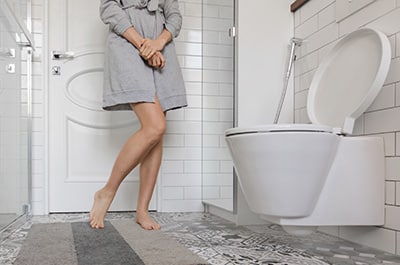Physiotherapy Treatment For Urinary Incontinence
Urinary incontinence (accidental loss of urine) is incredibly common. In fact, around ¼ of the population over the age of 15 experience incontinence. The prevalence is highest in women (particularly in older age or after having had a baby), but men are affected too. Urinary incontinence can lead to a loss of confidence, reduced participation in exercise and physical activity, less desire to leave the house, and is associated with an increased risk of falls in the elderly.
Luckily, help is at hand! Physiotherapists trained in pelvic health can assess what is contributing to your incontinence and develop an effective treatment plan targeted to your specific situation. So whilst urinary incontinence is common, it is not ‘normal’, and it is not something that you have to just live with. Seeing a pelvic health physiotherapist will give you the opportunity to discuss your incontinence in a safe and supportive environment, and give you a path back to the tasks and life you want to lead.
What causes urinary incontinence?
There are two main types of urinary incontinence:
1) Stress urinary incontinence
This type of leakage occurs when there is extra pressure in the abdomen. This can include activities such as laughing, coughing, sneezing, lifting, carrying, running, jumping, or other dynamic physical activities.

2) Urge urinary incontinence
This type of leakage occurs when the bladder forcibly contracts and is associated with a sudden strong desire to urinate. Urge urinary incontinence isn’t necessarily related to physical activity.
You may also have mixed urinary incontinence where there is a combination of stress and urge urinary incontinence.
There are many factors that can contribute to urinary incontinence. For stress urinary incontinence, there may be dysfunction in the pelvic floor muscles (such as weakness, a lack of endurance, or they may not be well coordinated), a lack of good bladder support (such as anterior wall prolapse), or poor control of pressure within the abdomen.
Urge urinary incontinence can also have many contributing factors, such as irritation of the bladder, poor bladder habits and constipation.
How is urinary incontinence treated?
In treating your urinary incontinence, we will first determine what is contributing to your leakage. This may be related to your pelvic floor function, your fluid intake (the amount of fluid you drink, when you drink the fluids and the type of fluids you consume), your bowel habits (particularly if you have constipation or are straining when going to the toilet), your pelvic organ position and supports (for example anterior wall prolapse) and the way you do the activities that cause your leakage. We may also need you to complete a bladder diary to give us a clear understanding of your bladder function.
Once we know what is contributing to your leakage, we will work with you to address all of these factors. This may include exercises to improve pelvic floor function, strategies to address constipation, bladder training and support of the pelvic organs. We will work with you throughout the whole treatment process to make sure you can regain control of your continence and get back to doing the things that you love!
If you have bothersome urinary incontinence, don’t be embarrassed. Come to Graceville Physio, Pain Slayers and see our physiotherapists. Contact us today to book an appointment.



